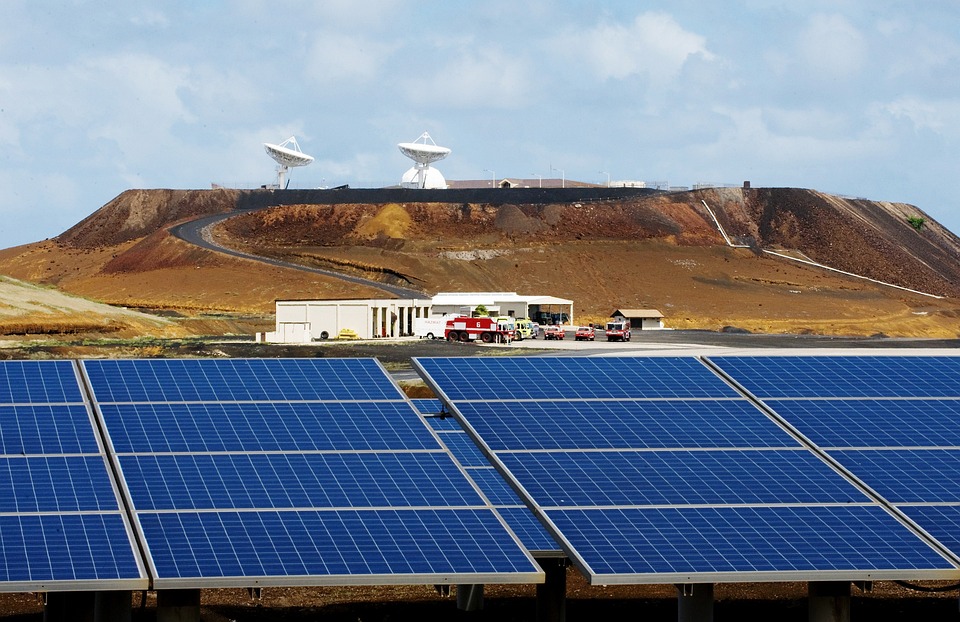From Sunlight to Electricity: The Technology Behind Solar Power
The Rising Popularity of Solar Power
In recent years, solar power has surged in popularity as an environmentally-friendly and cost-effective alternative to traditional energy sources. The technology behind solar power harnesses the energy from the sun and converts it into electricity that can power homes, businesses, and entire communities. Understanding the intricacies of this technology can shed light on its potential for widespread adoption and its impact on the future of energy production.
How Solar Panels Work
The core component of solar power technology is the solar panel, which is made up of numerous photovoltaic cells. These cells are typically made of silicon, a semiconductor material that can convert sunlight into electricity through the photovoltaic effect. When sunlight hits the solar panel, the photons in the sunlight knock electrons loose from the atoms in the silicon, generating an electric current.
- The top layer of a solar panel consists of silicon, phosphorus, and boron to create an electric field.
- When sunlight hits the panel, electrons are knocked loose and enter the electric field.
- These electrons are then captured as electrical energy and sent through wiring to provide power.
Types of Solar Panels
There are various types of solar panels, each with its own advantages and disadvantages. Monocrystalline solar panels are made from single-crystal silicon, making them highly efficient and durable. Polycrystalline solar panels, on the other hand, are made from multiple silicon crystals and are more affordable but less efficient. Thin-film solar panels are lightweight and flexible, making them suitable for a variety of installations. Understanding the differences between these types of panels can help consumers make informed decisions about their solar power investments.
Energy Storage and Grid Connection
One of the challenges of solar power is the intermittent nature of sunlight. To address this, energy storage solutions such as batteries can store excess energy generated during peak sunlight hours for use during periods of low sunlight. Grid connection also allows solar panel owners to feed excess energy back into the grid, earning credits or compensation for the electricity they generate. This integration of storage and grid connection ensures a reliable and consistent power supply from solar energy.
The Environmental Impact of Solar Power
Solar power is often lauded for its environmental benefits, as it produces no greenhouse gas emissions during electricity generation. By replacing fossil fuels with solar energy, we can reduce air and water pollution, conserve natural resources, and combat climate change. A study by the National Renewable Energy Laboratory found that widespread adoption of solar power could reduce greenhouse gas emissions by 25% by 2050.
Case Studies in Solar Power
Several countries and regions have made significant strides in implementing solar power technology. Germany, for example, has been a leader in solar power adoption, with over 1.7 million solar power systems installed across the country. In the United States, California has seen remarkable growth in solar energy capacity, with over 23,000 megawatts of solar power installed as of 2020. These case studies demonstrate the potential for solar power to transform energy infrastructure on a global scale.
Conclusion
The technology behind solar power has evolved rapidly in recent years, making it an increasingly viable and attractive option for energy production. By understanding the inner workings of solar panels, the types of solar power systems available, and the environmental and economic benefits of solar energy, consumers and policymakers can make informed decisions about integrating solar power into their energy portfolios. With further advancements in technology and continued investment in solar power infrastructure, the future of energy production looks increasingly bright.


Pingback: From Sunlight to Electricity: The Technology Behind Solar Power – Home Solar Sessions
гарантия при продаже аккаунтов магазин аккаунтов социальных сетей
аккаунты с балансом аккаунты с балансом
аккаунты с балансом перепродажа аккаунтов
маркетплейс для реселлеров маркетплейс аккаунтов
маркетплейс аккаунтов соцсетей платформа для покупки аккаунтов
купить аккаунт купить аккаунт
магазин аккаунтов социальных сетей аккаунт для рекламы
платформа для покупки аккаунтов перепродажа аккаунтов
купить аккаунт magazin-akkauntov-online.ru/
купить аккаунт с прокачкой https://ploshadka-prodazha-akkauntov.ru/
магазин аккаунтов социальных сетей prodat-akkaunt-online.ru/
маркетплейс аккаунтов соцсетей безопасная сделка аккаунтов
площадка для продажи аккаунтов профиль с подписчиками
Account Exchange Service Account exchange
Purchase Ready-Made Accounts Account marketplace
Account marketplace Marketplace for Ready-Made Accounts
Buy Pre-made Account Account Buying Service
Accounts marketplace Account Catalog
Account Purchase https://buyagedaccounts001.com/
Account Catalog Account Selling Platform
Website for Selling Accounts Account Exchange Service
Verified Accounts for Sale Account Store
accounts for sale account market
account purchase account store
account purchase online account store
buy accounts buy account
account exchange service account trading platform
marketplace for ready-made accounts account buying service
sell pre-made account accounts market
account buying service accountsmarketdiscount.com
secure account sales ready-made accounts for sale
verified accounts for sale marketplace for ready-made accounts
account sale buy account
sell accounts https://buy-soc-accounts.org/
account trading platform buy accounts
account purchase sell accounts
account trading platform sell account
guaranteed accounts marketplace for ready-made accounts
profitable account sales buy and sell accounts
buy and sell accounts account marketplace
account catalog https://buy-online-accounts.org
buy pre-made account account selling platform
profitable account sales account market
secure account purchasing platform account exchange
ready-made accounts for sale sale-social-accounts.org
verified accounts for sale buy and sell accounts
account trading sell accounts
profitable account sales accounts-buy-now.org
buy and sell accounts top-social-accounts.org
account trading platform https://accounts-offer.org
ready-made accounts for sale https://accounts-marketplace.xyz/
account buying platform https://buy-best-accounts.org
account buying service https://social-accounts-marketplaces.live/
accounts market https://accounts-marketplace.live/
online account store https://social-accounts-marketplace.xyz
database of accounts for sale https://buy-accounts.space
buy account buy-accounts-shop.pro
buy account https://buy-accounts.live
social media account marketplace https://social-accounts-marketplace.live
account selling service https://accounts-marketplace.online
website for buying accounts https://accounts-marketplace-best.pro
маркетплейс аккаунтов соцсетей https://akkaunty-na-prodazhu.pro
продать аккаунт https://rynok-akkauntov.top/
покупка аккаунтов купить аккаунт
магазин аккаунтов https://akkaunt-magazin.online
маркетплейс аккаунтов https://akkaunty-market.live
маркетплейс аккаунтов соцсетей kupit-akkaunty-market.xyz
магазин аккаунтов akkaunty-optom.live
маркетплейс аккаунтов https://online-akkaunty-magazin.xyz/
продать аккаунт купить аккаунт
маркетплейс аккаунтов kupit-akkaunt.online
facebook account buy buy facebook ads account
buy account facebook ads https://buy-ad-accounts.click
buy fb ad account https://buy-ad-account.top
facebook ads account buy https://ad-account-buy.top
cheap facebook accounts https://buy-ads-account.work
buy aged facebook ads account buy a facebook ad account
buy facebook account for ads facebook ads account for sale
facebook account buy buy facebook ad account
google ads accounts for sale https://buy-ads-account.top
google ads account for sale https://buy-ads-accounts.click
buy ad account facebook https://buy-accounts.click
google ads account for sale buy adwords account
buy google ad threshold account buy google ads invoice account
buy google ads https://buy-ads-invoice-account.top
buy google ad account https://buy-account-ads.work
buy aged google ads account buy google ads account
google ads reseller google ads account for sale
buy google ads invoice account https://ads-agency-account-buy.click
buy verified business manager https://buy-business-manager.org
buy verified google ads account buy google ads accounts
facebook business manager for sale https://buy-bm-account.org
facebook bm account buy business manager account
verified facebook business manager for sale buy-verified-business-manager-account.org
verified bm for sale https://buy-verified-business-manager.org
buy bm facebook https://business-manager-for-sale.org/
buy verified bm https://buy-business-manager-verified.org/
verified bm for sale buy-bm.org
unlimited bm facebook verified-business-manager-for-sale.org
buy verified bm facebook buy-business-manager-accounts.org
tiktok ads account buy buy tiktok business account
buy tiktok ads account https://tiktok-ads-account-buy.org
buy tiktok ads account https://tiktok-ads-account-for-sale.org
tiktok ads agency account https://tiktok-agency-account-for-sale.org
buy tiktok ads accounts https://buy-tiktok-ad-account.org
buy tiktok ads account https://buy-tiktok-ads-accounts.org
tiktok ads account for sale https://buy-tiktok-business-account.org
buy tiktok business account https://tiktok-ads-agency-account.org
buy tiktok ads accounts tiktok ads account buy
Explore the ranked best online casinos of 2025. Compare bonuses, game selections, and trustworthiness of top platforms for secure and rewarding gameplaycasino bonus.
buy facebook old accounts account acquisition guaranteed accounts
buy accounts facebook secure account sales verified accounts for sale
I’m grateful for the new perspective you’ve given me on this subject. Thank you!
I appreciate your emphasis on [specific point], especially in a world where… For anyone interested, Free Platform has great resources on this.
I’m impressed by how you manage to cover so much ground without overwhelming the reader. Great!
I appreciate how you include both theoretical knowledge and practical applications.
I appreciate the time and effort you put into creating this content.